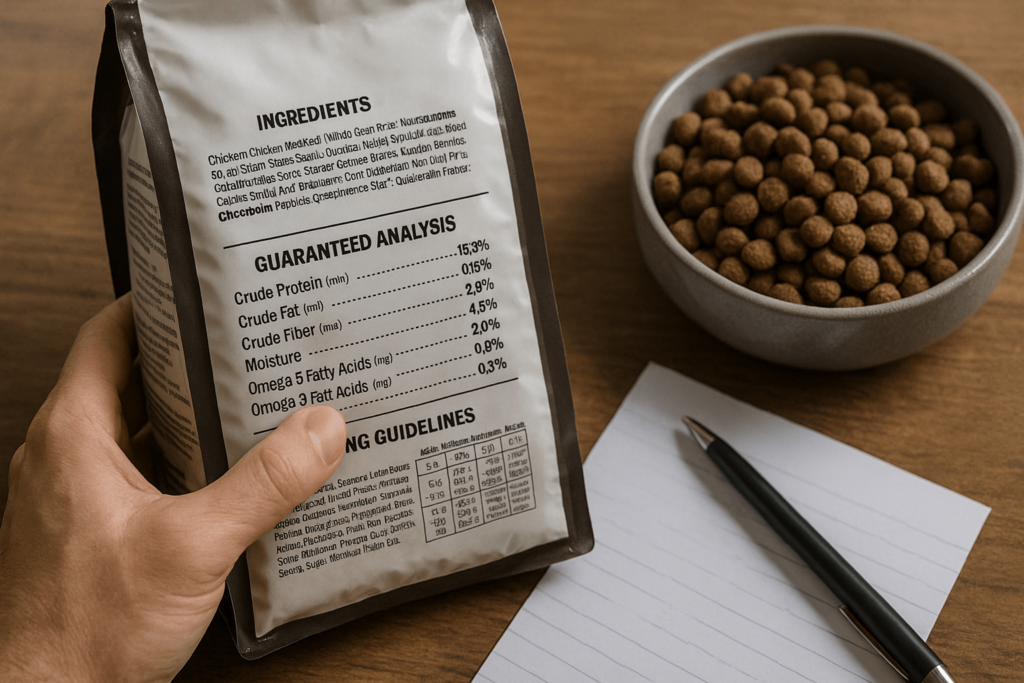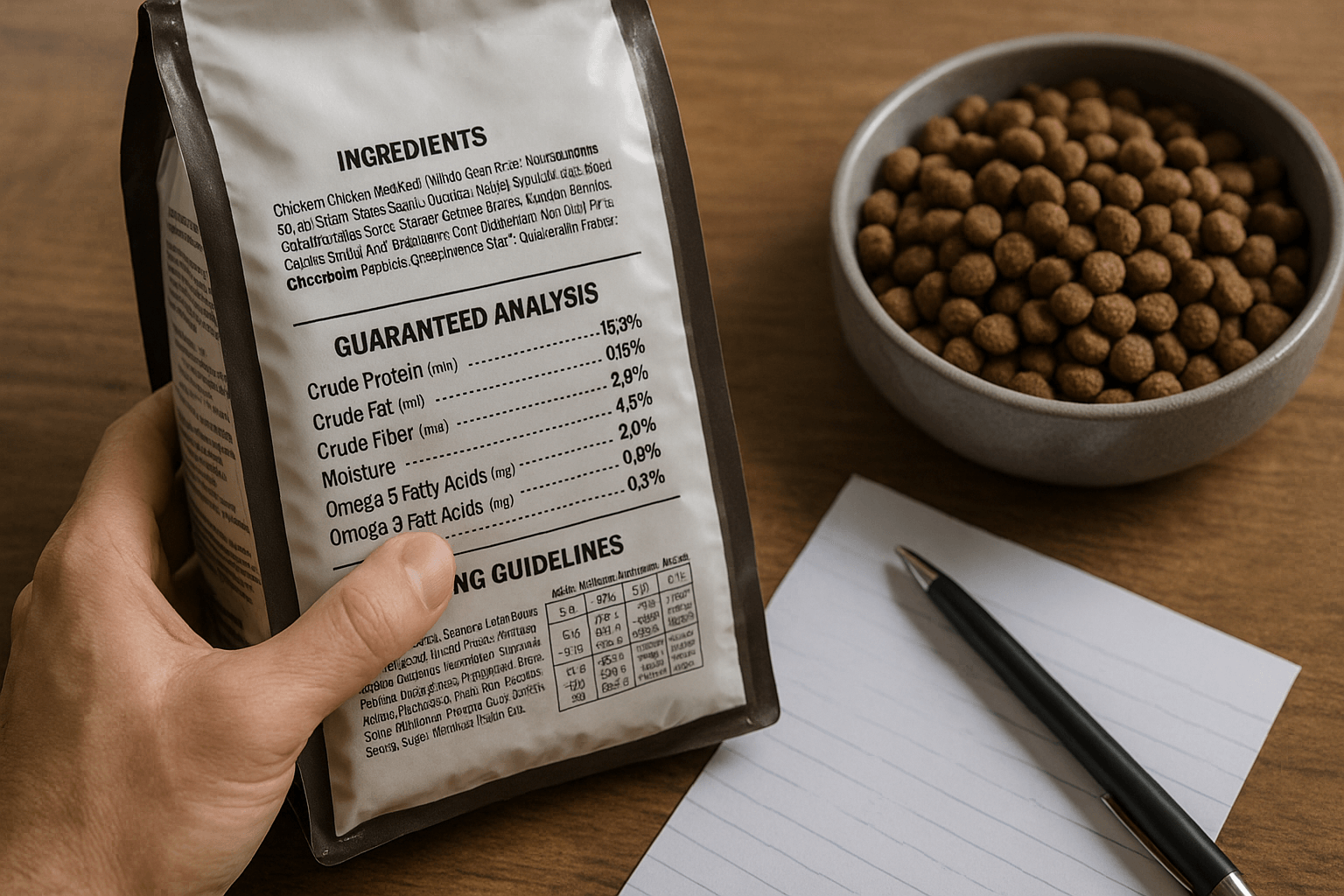How to Read Dog Food Labels: Decode the Bag and Feed Your Dog Right
Dog food labels look like a science experiment gone wrong—tiny print, confusing terms, and claims that sound impressive but mean little. But beneath the marketing fluff lies critical information about your dog’s health. Learning how to read dog food labels isn’t just helpful—it’s essential. Your dog depends on you to choose food that fuels their body, supports their immune system, and promotes a long, vibrant life. This guide cuts through the noise and teaches you exactly what to look for—and what to avoid.
Why Dog Food Labels Matter More Than You Think
The label on your dog’s food bag is their nutritional blueprint. It doesn’t just list ingredients—it reveals the quality, safety, and suitability of every bite. Ignoring it is like driving a car without checking the fuel type.
It tells you what’s inside:
The ingredient list reveals whether your dog’s meal is packed with real meat or cheap fillers like corn gluten meal or poultry by-product meal.It reveals the nutritional adequacy:
Only foods labeled “complete and balanced” meet AAFCO standards for your dog’s life stage—puppy, adult, or senior.It exposes marketing tricks:
Words like “natural,” “premium,” or “holistic” have no legal definition—your dog doesn’t benefit from them unless the ingredients prove it.It protects against allergens:
If your dog has sensitivities, the label is your only defense against hidden ingredients like wheat, soy, or chicken.It guides portion control:
Feeding guidelines based on weight and activity level prevent obesity—a leading cause of early death in dogs.
Reading the label isn’t optional. It’s the first step in preventing disease, managing weight, and giving your dog the nutrition they deserve.

The 5 Critical Sections of a Dog Food Label (And What They Really Mean)
Every bag has the same core components—but most owners skim past them. Here’s what each section truly reveals about your dog’s food.
Product Name:
Look for “Chicken Dog Food” over “Chicken Dinner.” The former must contain at least 95% chicken (excluding water). “Dinner” only needs 25%. Names are legally regulated—use them to judge quality.Ingredient List:
Ingredients are listed by weight before processing. The first five determine 70% of the food. Prioritize named meats (e.g., “chicken,” “salmon”) over vague terms like “meat meal” or “animal by-products.”Guaranteed Analysis:
This section gives minimum protein, fat, and maximum fiber and moisture percentages. Compare these numbers across brands. A puppy food should have at least 22% protein; an adult dog needs 18% or more.Nutritional Adequacy Statement:
This is the golden ticket. It must state: “Formulated to meet the nutritional levels established by the AAFCO Dog Food Nutrient Profiles for [Life Stage].” Without this, the food is incomplete and unsafe for long-term feeding.Feeding Guidelines:
These are starting points—not rules. Adjust based on your dog’s breed, activity level, and body condition. A 50-pound Labrador needs far less than a 50-pound Chihuahua mix if the latter is hyperactive.
Your dog’s health lives in these five sections. Master them, and you’ll never buy another bag based on a cute logo or a celebrity endorsement.
Check this guide 👉Kibble vs Canned Dog Food: Best 7 Expert Tips!
Check this guide 👉Is It Bad to Switch Dog Food? Best 7 Expert Tips!
Check this guide 👉Dog Food for Pregnant Dogs: Best 7 Expert Tips!
| Label Element | What to Look For |
|---|---|
| Product Name | Choose names with “Chicken Dog Food” over “Chicken Flavor” or “Chicken Dinner.” Higher percentage = better quality. |
| Ingredient List | First ingredient must be a named animal protein (e.g., “beef,” “turkey”). Avoid “meat meal,” “by-products,” or “corn gluten.” |
| Guaranteed Analysis | Puppies: >22% protein, >8% fat. Adults: >18% protein, >5% fat. Avoid foods with fiber >6% unless for weight loss. |
| Nutritional Adequacy Statement | Must include “AAFCO” and specify life stage (e.g., “for adult maintenance”). No AAFCO = unsafe for daily feeding. |
| Feeding Guidelines | Use as a baseline. Adjust up or down based on your dog’s energy, body condition, and vet advice. Don’t overfeed! |
The Hidden Dangers in Dog Food Labels
Marketing terms are designed to confuse. Here’s what “natural,” “grain-free,” or “premium” really mean—and why they might be doing more harm than good.
“Natural” Doesn’t Mean Healthy:
Legally, “natural” just means no artificial colors or preservatives. It says nothing about ingredient quality. A bag of “natural” food can still be 70% corn.“Grain-Free” Is Often a Trap:
Grain-free doesn’t mean low-carb. Many replace grains with potatoes, peas, or lentils—which are linked to canine dilated cardiomyopathy (DCM) in some breeds.“Premium” Has No Legal Meaning:
There’s no regulatory definition. A “premium” brand could cost $50 a bag but contain low-quality meat meal and fillers.“Made in the USA” Isn’t a Guarantee:
The label can say “Made in the USA” even if ingredients are imported. Look for “Sourced in the USA” for true domestic quality.“No Fillers” Is a Red Herring:
All ingredients serve a purpose. Fiber from beet pulp? It’s safe and aids digestion. “Filler” is a marketing word—not a scientific one.
Don’t be fooled by buzzwords. Go deeper. Ask: What’s the first ingredient? Is it named meat? Is there AAFCO approval? That’s the real test.
How to Match Food to Your Dog’s Life Stage and Health Needs
A one-size-fits-all diet doesn’t exist. Your 8-week-old puppy, 7-year-old Labrador, and 12-year-old senior Chihuahua all need radically different nutrition.
Puppies:
Need high protein (22–32%) and fat (8–15%) for growth. Look for “for growth” or “for all life stages” on the label. Avoid adult formulas—they lack essential nutrients.Adult Dogs:
Require balanced protein (18–25%) and moderate fat (10–15%). Choose “for adult maintenance.” Active breeds need more calories; sedentary dogs need less.Senior Dogs:
Benefit from lower fat (8–12%), moderate protein (18–22%), and added joint support (glucosamine, chondroitin). Avoid high-calorie formulas—they lead to obesity.Dogs with Allergies:
Look for limited-ingredient diets (LID) with one protein and one carb source. Avoid common allergens: beef, chicken, dairy, wheat, soy, corn.Dogs with Medical Conditions:
Kidney disease? Look for low phosphorus and protein. Diabetes? Seek high fiber, low glycemic carbs. Always consult your vet before switching.
Your dog’s label should match their age, activity, and health—not your convenience.
Understanding Meat Sources: Named Proteins vs. By-Products
Not all protein is created equal. The difference between “chicken” and “poultry by-product meal” is the difference between nourishment and neglect.
Named Animal Proteins (Best):
“Chicken,” “beef,” “salmon,” “lamb.” These are specific, whole muscle meats. High in digestible amino acids.Meat Meals (Good):
“Chicken meal,” “lamb meal.” Concentrated protein after water and fat are removed. High quality if named and from reputable sources.By-Product Meals (Use with Caution):
“Poultry by-product meal” includes heads, feet, intestines, and feathers. Nutritional value varies wildly—often low quality.Animal Digest (Avoid):
A chemically processed flavor enhancer. May contain rendered animal parts. Adds taste, not nutrition.Generic Terms (Never Trust):
“Meat,” “animal protein,” “fish meal.” These hide the source. Could be low-grade, diseased, or contaminated.
Always choose labeled, specific proteins. If the label says “meat,” walk away.
The Truth About Carbohydrates and Fillers in Dog Food
Dogs aren’t wolves—but they’re not grain-eating humans either. Carbs aren’t evil, but too many are dangerous.
High-Quality Carbs (Acceptable):
Brown rice, oats, sweet potatoes. Provide energy and fiber. Safe in moderation (under 40% of formula).Low-Quality Carbs (Avoid):
Corn, wheat, soy. Cheap fillers with poor digestibility. Linked to allergies and inflammation.Legume-Based Carbs (Risky):
Peas, lentils, chickpeas. Common in grain-free foods. Linked to heart disease in some breeds per FDA studies.Artificial Fillers (Dangerous):
Corn syrup, cellulose, caramel color. Add bulk, texture, or color—zero nutrition.Fiber Sources (Useful):
Beet pulp, psyllium husk. Aid digestion. Safe in small amounts (under 5%).
Aim for 30–40% total carbs. More than 50% means the food is mostly filler. Your dog’s pancreas wasn’t built for sugar spikes.
Common Labeling Tricks and How to Spot Them
Manufacturers use psychology, not science, to sell food. Here’s how to see through the smoke.
Front-Label Promises:
“With Real Chicken” means less than 3% chicken. The rest could be rice and soy.“No Artificial Preservatives”:
Often replaced with chemical alternatives like “mixed tocopherols” (vitamin E)—which are natural, but still preservatives.“Made with Organic Ingredients”:
Doesn’t mean the whole food is organic. Could be 1% organic chicken, 99% non-organic fillers.“Veterinarian Recommended”:
Often means the brand paid the vet or clinic for endorsement—not that the food is superior.“Holistic” or “Natural”:
These terms are unregulated. They mean nothing without proof in the ingredient list.
Trust numbers, not adjectives. If it sounds too good to be true, it probably is.
FAQ: How to Read Dog Food Labels
What does “complete and balanced” actually mean?
It means the food meets AAFCO nutrient profiles for a specific life stage. Without this statement, the food is not safe for long-term feeding.
Should I avoid dog food with corn?
Not necessarily. Corn is a digestible carbohydrate and protein source if it’s not the first ingredient. Avoid it only if your dog has a confirmed allergy.
Is grain-free better for dogs?
Only if your dog has a grain allergy. For most dogs, grain-free is unnecessary—and potentially harmful due to legume-linked heart disease.
How do I know if the protein is high quality?
Look for named animal proteins (chicken, beef) as the first ingredient. Avoid “meat meal” or “by-products” unless clearly specified.
Can I trust “vet-recommended” on the bag?
No. Many brands pay veterinarians or clinics for endorsements. Always check the ingredient list and AAFCO statement yourself.
Feed with Confidence, Not Confusion
Reading dog food labels isn’t about becoming a nutritionist—it’s about becoming your dog’s advocate. You don’t need to memorize every term. You just need to know where to look: the first ingredient, the AAFCO statement, and the guaranteed analysis. Those three things tell you everything you need to know.
Your dog doesn’t care about the color of the bag or the cute puppy on the front.
They care about whether their food gives them energy, supports their joints, keeps their coat shiny, and helps them live longer.
Canned Pumpkin for Cat Diarrhea: Best 7 Expert Tips! Natural remedy to firm stools, soothe upset bellies, and support gut health safely.
Can a Cat Give You Scabies? Best 7 Expert Tips! Discover the truth about feline mites, human skin risks, and how to protect yourself—without panic.
Cat Flea vs Human Flea: Best 7 Expert Tips! Discover the truth about bites, species, and how to eliminate infestations for good.
Weird Cat Behaviors: Best 7 Expert Tips! Discover why cats do strange things—and how to understand, not punish, their instincts for a happier home.





